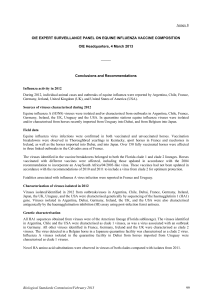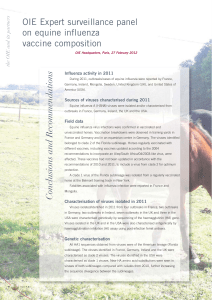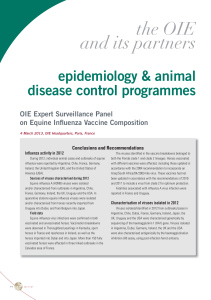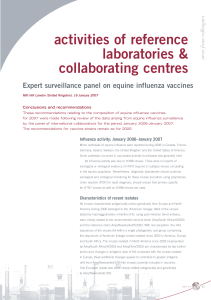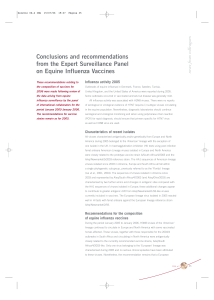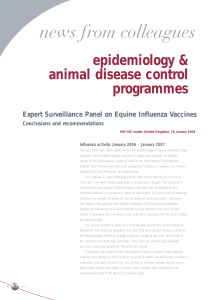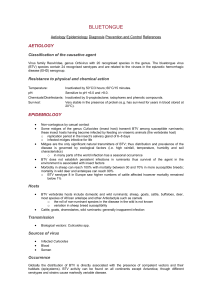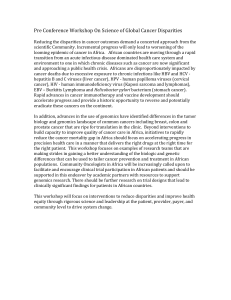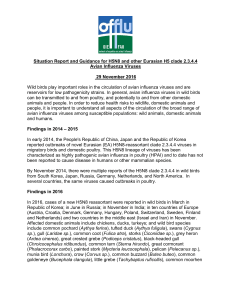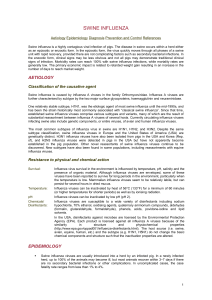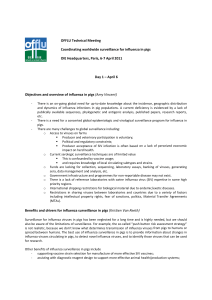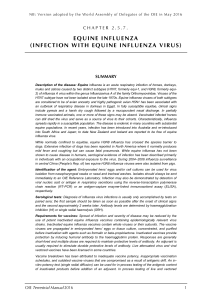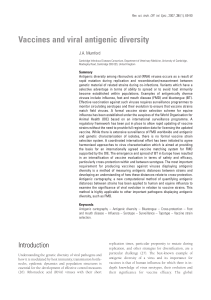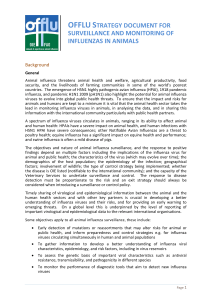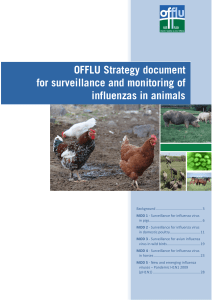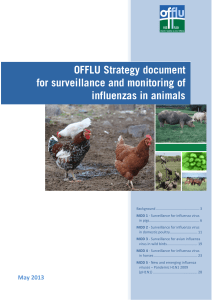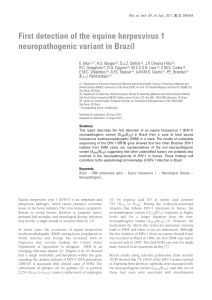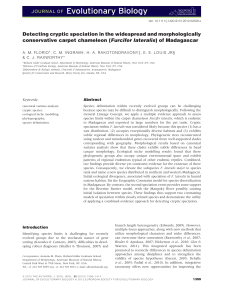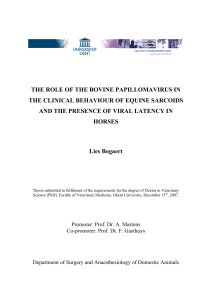D13303.PDF
publicité
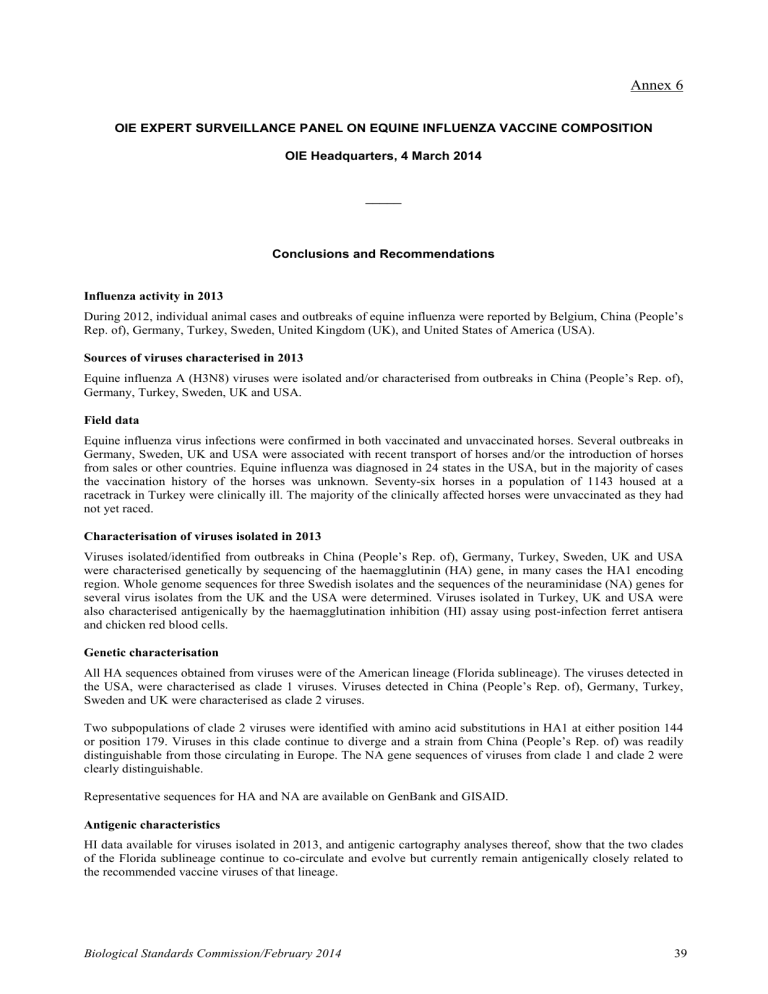
Annex 6 OIE EXPERT SURVEILLANCE PANEL ON EQUINE INFLUENZA VACCINE COMPOSITION OIE Headquarters, 4 March 2014 _____ Conclusions and Recommendations Influenza activity in 2013 During 2012, individual animal cases and outbreaks of equine influenza were reported by Belgium, China (People’s Rep. of), Germany, Turkey, Sweden, United Kingdom (UK), and United States of America (USA). Sources of viruses characterised in 2013 Equine influenza A (H3N8) viruses were isolated and/or characterised from outbreaks in China (People’s Rep. of), Germany, Turkey, Sweden, UK and USA. Field data Equine influenza virus infections were confirmed in both vaccinated and unvaccinated horses. Several outbreaks in Germany, Sweden, UK and USA were associated with recent transport of horses and/or the introduction of horses from sales or other countries. Equine influenza was diagnosed in 24 states in the USA, but in the majority of cases the vaccination history of the horses was unknown. Seventy-six horses in a population of 1143 housed at a racetrack in Turkey were clinically ill. The majority of the clinically affected horses were unvaccinated as they had not yet raced. Characterisation of viruses isolated in 2013 Viruses isolated/identified from outbreaks in China (People’s Rep. of), Germany, Turkey, Sweden, UK and USA were characterised genetically by sequencing of the haemagglutinin (HA) gene, in many cases the HA1 encoding region. Whole genome sequences for three Swedish isolates and the sequences of the neuraminidase (NA) genes for several virus isolates from the UK and the USA were determined. Viruses isolated in Turkey, UK and USA were also characterised antigenically by the haemagglutination inhibition (HI) assay using post-infection ferret antisera and chicken red blood cells. Genetic characterisation All HA sequences obtained from viruses were of the American lineage (Florida sublineage). The viruses detected in the USA, were characterised as clade 1 viruses. Viruses detected in China (People’s Rep. of), Germany, Turkey, Sweden and UK were characterised as clade 2 viruses. Two subpopulations of clade 2 viruses were identified with amino acid substitutions in HA1 at either position 144 or position 179. Viruses in this clade continue to diverge and a strain from China (People’s Rep. of) was readily distinguishable from those circulating in Europe. The NA gene sequences of viruses from clade 1 and clade 2 were clearly distinguishable. Representative sequences for HA and NA are available on GenBank and GISAID. Antigenic characteristics HI data available for viruses isolated in 2013, and antigenic cartography analyses thereof, show that the two clades of the Florida sublineage continue to co-circulate and evolve but currently remain antigenically closely related to the recommended vaccine viruses of that lineage. Biological Standards Commission/February 2014 39 Annex 6 (contd) OIE Expert surveillance panel on equine influenza vaccine composition/March 2014 Conclusions No Eurasian viruses were detected in 2013. Viruses isolated and characterised were from clades 1 and 2 of the Florida sublineage. Level of surveillance and updating of vaccines The Panel continues to emphasise the importance of increased surveillance and investigation of vaccination breakdown in different countries. Increased surveillance in Asia has been facilitated by the OIE twinning programme. Rapid submission of viruses to reference laboratories is essential if antigenic and genetic drift is to be monitored effectively on a global basis. Although one vaccine available within the American market has been updated to include a virus from clade 2, in accordance with the recommendations of 2010 to 2013, the majority of current vaccines contain out-dated strains. The updating of vaccines with epidemiologically relevant viruses is necessary for optimum protection. The Panel welcomes the Revision of the EU Guideline on Data Requirements for Strain Updates to Equine Influenza Vaccines and any amendments to regulatory procedures that allow equine influenza vaccines to be updated as speedily as possible without compromising safety and efficacy. Recommendations (March 2014) These are unchanged from those made in March 2013. It is not necessary to include an H7N7 virus or an H3N8 virus of the Eurasian lineage in vaccines as these viruses have not been detected in the course of the most recent surveillance and are therefore presumed not to be circulating. Vaccines for the international market should contain both clade 1 and clade 2 viruses of the Florida sublineage. Clade 1 is represented by A/eq/South Africa/04/2003-like or A/eq/Ohio/2003-like viruses. Clade 2 is represented by A/eq/Richmond/1/2007-like viruses. A panel of viruses covering both clades is available from the OIE Reference Laboratories. Manufacturers producing vaccines for a strictly national market are encouraged to liaise with Reference Laboratories. The selected viruses should induce responses which are immunogenically relevant to the equine influenza viruses circulating nationally. Sequence determination of both HA and NAs should be completed before use. Reference reagents Freeze-dried post-infection equine antisera to A/eq/Newmarket/1/93 (American lineage H3N8) and A/eq/South Africa/4/2003 (Florida clade 1, sublineage of the American lineage) are available from the European Directorate for the Quality of Medicines (EDQM). These sera have been assigned single radial haemolysis (SRH) values through an international collaborative study and can be used as primary reference sera for the assay. There is no SRH reference serum available currently for A/eq/Richmond/1/2007, representative of Florida clade 2. There is currently a shortage of single radial diffusion (SRD) reagents and they will no longer be produced by the National Institute for Biological Standards and Control (NIBSC). There is a need for updated SRD regents for both Florida clade 1 and clade 2. Recent virus strains, including suitable vaccine candidates for clades 1 and 2, are available from the OIE Reference Laboratories. In the event that an OIE Reference Laboratory cannot supply suitable vaccine candidates for both clades, it will assist the vaccine company to source the viruses from an alternative OIE Reference Laboratory. Small quantities of ferret antisera for antigenic characterisation are available from the OIE Reference Laboratory in the UK. _______________ 40 Biological Standards Commission/February 2014 OIE Expert surveillance panel on equine influenza vaccine composition/March 2014 Annex 6 (contd) OIE EXPERT SURVEILLANCE PANEL ON EQUINE INFLUENZA VACCINE COMPOSITION OIE Headquarters, 4 March 2014 _____ List of Participants OIE Reference laboratories Other experts Other experts (cont.) Prof. Ann Cullinane Head of the Virology Unit Irish Equine Centre Johnstown, Naas Co. Kildare IRELAND Prof. Vincenzo Caporale (President, OIE Biological Standards Commission) Colleatterrato Alto 64100 Teramo ITALY Dr Loic Legrand Frank Duncombe Laboratory University of Caen Basse-Normandie Caen Cedex FRANCE Dr Thomas M. Chambers Maxwell H. Gluck Equine Research Center Department of Veterinary Science University of Kentucky 108 Gluck Equine Research Center Lexington, Kentucky 40546-0099 UNITED STATES OF AMERICA Professor Xiaojun Wang Harbin Veterinary Research Institute, CAAS 427 Maduan Street, Harbin, 150001 CHINA (PEOPLE’S REP. OF) Dr Debra Elton Animal Health Trust Centre for Preventive Medicine Lanwades Park, Kentford Suffolk CB8 7UU UNITED KINGDOM Dr Armando Damiani Institute of Virology Veterinary Medicine Free University of Berlin Philippstrasse 13, Haus 18 10115 Berlin GERMANY WHO laboratories Professor Derek Smith WHO Collaborating Centre for Modelling, Evolution, and Control of Emerging Diseases University of Cambridge UNITED KINGDOM Dr Nicola Lewis WHO Collaborating Centre for Modelling, Evolution, and Control of Emerging Diseases University of Cambridge UNITED KINGDOM Dr Nitin Virmani Principal Scientist National Research Centre on Equines Sirsa Road, Hisar 125 001 (Haryana) INDIA Dr Takashi Yamanaka Epizootic Research Center Equine Research Institute Japan Racing Association 1400-4 Shiba, Shimotsuke Tochigi, 329-0412 JAPAN Dr María Barrandeguy Responsable del Laboratorio de Virus Equinos Instituto de Virología CICVyA INTA ARGENTINA Dr Louise Treiberg Berndtsson Statens Veterinärmedicinska Anstalt 751 89 Uppsala SWEDEN Dr Adam Rash BSc Animal Health Trust Centre for Preventive Medicine Lanwades Park, Kentford Suffolk CB8 7UU UNITED KINGDOM _______________ Biological Standards Commission/February 2014 41
